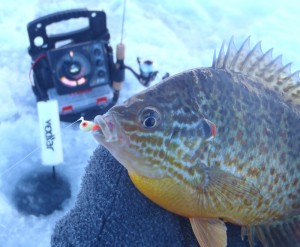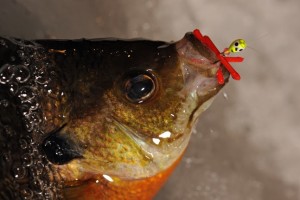There can be surprisingly solid ice fishing, where there are no weeds, for panfish on lakes and reservoirs that lack classic weed growth. From an ice fishing perspective, good weeds in the wintertime often correlates with good water visibility. Poor water visibility, turbidity or exposure to strong winds might create panfish water that might offer at least shallow weed beds during the summer but by winter, most of the weed bed is down.
There are also some reservoirs particularly in the Great Plains States built to provide irrigation and the drawdown prohibits good weed growth from ever developing. Many anglers mistakenly believe that most great panfish water has good aquatic vegetation. That is not the case and lakes that are devoid of any aquatic vegetation often require completely different strategies.
In some ways, when ice fishing no weeds on water that lacks the classic weed cover can be easier to fish. Because fish concentrate on what cover is present. Some reservoirs have submerged timber that hold fish. As a general rule of thumb, many flowages, reservoirs and natural lakes that don’t have good weed growth often have submerged brush piles or cribs that attract fish. Some of this fish habitat planted by State Agencies have GPS coordinates available to the public. The legality of planting brush piles and tree clippings varies from state to state but even on water where it is illegal to plant fish attracting cover, brush piles and cinder blocks miraculously show up on the bottom of some lakes for those of you ice fishing no weeds. Typically, this man made structure becomes a lot more attractive to fish if the water lacks natural existing cover.
If you can find these locations and fish them through the ice, there is usually no shortage of fish. The toughest aspect of catching fish in these environments is finding these locations. Perhaps the easiest way to find these locations fast is to run the water during the summer with side scanning. Sunken trees, man made brush piles, cribs and any other cover that can hold fish shows up fast with side scanning. Mark waypoints and return when the water freezes.
Finding these locations on the ice however can be much more daunting. If water visibility allows, this is a scenario where underwater cameras like the Vexilar Fish Phone can shine. The Fish Phone is an underwater camera that uses your iPhone or Android for the display and is an easy and cheap way to view effectively underwater with recording options.
Typically, good spots hold good fish in that brush piles, cribs and fallen trees that have a lot of branches, variations and size hold more fish and larger fish. Good spots are relative in that we have seen what looked like fifty or more crappie holding next to one single branch coming off a tree lying on the bottom. That particular scenario had a barren lake bottom that was virtually void of any cover. Water that has more options typically gives the fish more choices and fish have a way of finding the best locations.
Even on a single brush pile, there will often be a sweet spot that really seems to attract the fish. Might be a spot where the branches are higher or denser or could simply be the side of the brush pile facing deeper water.
From my own experiences fishing these types of locations, this is not always a situation where you run and gun hitting several spots but you do often have to drill several holes to get positioned over the spot perfectly and again the best way to do this is by using an underwater camera.
Often, what we find is that these locations will recharge very well if you are alone on the location. That is… set up over the sweet spot and let the fish come to you. You initially catch the fish that are living right below you and new fish seem to set up on the spot to take the place of the fish that were caught.
Because you are stationary over a key location, the location itself is almost surgical. You have to spend some time to figure out where to drill a hole in the exact right spot and than wait out fish movements… a perfect scenario to camp out for longer periods of time with a Fish Trap and underwater camera.
 The disadvantage of a camera for ice fishing is that they take longer to set up compared to just dropping a transducer down the hole and sending your lure down. You have to commit to a spot somewhat because of this extra time but this type of scenario is where the camera gives you a huge advantage because you watch how fish respond to your presentation distinctly and you sort fish you want to catch effectively.
The disadvantage of a camera for ice fishing is that they take longer to set up compared to just dropping a transducer down the hole and sending your lure down. You have to commit to a spot somewhat because of this extra time but this type of scenario is where the camera gives you a huge advantage because you watch how fish respond to your presentation distinctly and you sort fish you want to catch effectively.
On lakes, reservoirs and flowages that are devoid of weed growth or don’t offer ample flooded or submerged timber to hold panfish, taking the time to find other cover options can pay off huge dividends. Of course these more barren environments can see fish patterns over soft basins, main lake structure, the sides of creek channels and even rock, any type of cover is a fish magnet in these particular ecosystems when the target is bluegill or crappie. The effort to discover these types of locations is time well spent.
By Jason Mitchell

